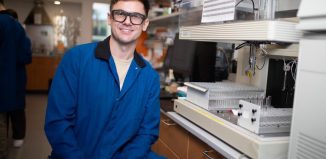SBU’s Helene Benveniste studies the glymphatic system
Future results and discoveries may help stave off the symptoms of Alzheimer’s
Like other parts of the body, the brain produces waste that needs to be cleared away. Through the so-called glymphatic system, the brain uses a type of water channel to remove tau proteins and other products.
When the glymphatic system isn’t functioning properly, these proteins do not clear correctly from the brain. From this research, scientists believe a breakdown may lead to or exacerbate problems related to the development of Alzheimer’s or chronic traumatic encephalopathy, a progressive degenerative disease that is often caused by multiple concussions.
“Normally, we produce proteins and peptides that are getting excreted,” explained Helene Benveniste, a professor in the Department of Anesthesiology and Radiology at Stony Brook University’s School of Medicine. It’s not under a lot of pressure, so it’s a slower process, but it’s like taking a water hose to a dirty street, she said. “If this system doesn’t work, compounds may build up and could lead to diseases.”
While scientists and medical researchers knew a defect in the clearing system could lead to neurological problems, they weren’t sure how to track the clearing process in real time.
That’s where Benveniste — who works one day a week in the operating room as a clinical anesthesiologist and the rest of the time in research — entered the picture. Using magnetic resonance imaging, she was able to use two different contrast agents to map this pathway, where she also found important clearance pathways for brain waste. The studies were done on an animal model.
The contrast approach is “a common way of detecting leaks,” she explained.
By using this same technique, she and her team were able to follow the glymphatic process, which often operated in parallel to major arteries.
Using these imaging techniques, doctors may be able to monitor the human brain to determine disease susceptibility. Through several MRI views over time, doctors might be able to detect signs of problems with the glymphatic system before a patient shows any symptoms of Alzheimer’s.
She hopes one day that doctors will track individuals who “may be susceptible” to Alzheimer’s.
“Anything we can do now to understand how a pathological process is building or is imminently developing in a human with the end result of Alzheimer’s is incredibly valuable,” said Benveniste.
While there is no cure for Alzheimer’s, tracking it before an intellectual slide into a potentially irreversible course of the disease may provide some effective preclinical intervention.
If doctors could slow down Alzheimer’s by 20 to 30 percent, they might not prevent people from getting the disease, but they might extend the time period during which individuals can live independent lives, she suggested.
“The impact on health costs and society is tremendous,” Benveniste said. “Do I think this is just a diagnostic tool or could it teach us something about how we might treat Alzheimer’s? The answer is yes, this might be important for that purpose.”
The challenge, and it’s significant, is to understand how the glympathic system works in the human brain, so that doctors can manipulate it.
There are also studies that show that some people have tau and amyloid in their brains who don’t show signs of Alzheimer’s. However, she said, there are pathological diagnostic criteria which can quantify the impact of the proteins present and often, the severity of the pathology correlates with the cognitive decline.
If, as Benveniste believes, these channels become critically important early signs of a susceptibility to disease or a preclinical state for the disease, researchers would also need to develop more therapies.
She doesn’t have any direct family experience with Alzheimer’s. She feels blessed that her 93-year-old mother is still sharp mentally.
A native of Copenhagen, Benveniste came to the United States in 1989, where she worked at Duke for 11 years. She came to Stony Brook in 2000.
She travels regularly back to Denmark. Those trips may prove especially valuable because Stony Brook is obtaining a PET/MRI machine, which is expected to be installed in the summer. In Copenhagen, they have had this same system up and running for over a year and she plans to travel in the next few months to Copenhagen to see how they are running their machine.
She and her husband, Peter Huttemeier, a retired anesthesiologist, met in Copenhagen. They live in Northport, where being so close to the water reminds them of Denmark.
As for her work, Benveniste hopes that the ability to track the glymphatic system leads to considerably more research from her colleagues in and out of Stony Brook.






